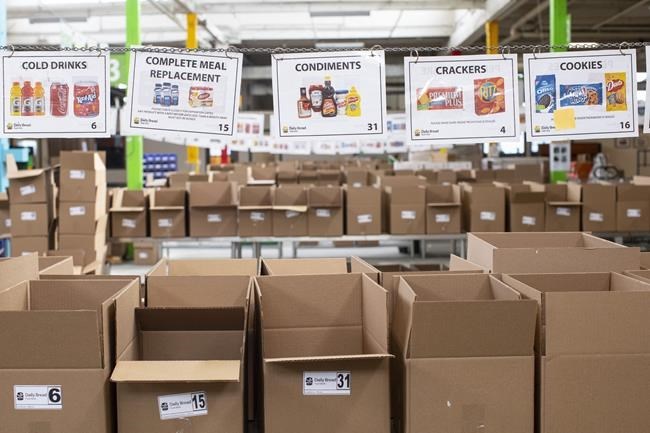TORONTO — Ontario residents have been visiting food banks in greater numbers and more often for six years running, a coalition of hunger relief organizations said Monday, noting the troubling trend appeared to escalate during the most recent year on record.
The findings are laid out in a new report from Feed Ontario, a collective of 1,200 direct and affiliate food banks and other organizations that work to address food insecurity.
The annual Hunger Report, subtitled "The Deepening Cracks in Ontario’s Economic Foundation," found 587,000 adults and children visited the province's food banks a total of 4.3 million times betweenApril 1, 2021 and March 31, 2022. Feed Ontario said that represents a 15 per cent spike in the number of people turning to food banks for aid and a 42 per cent surge in the number of visits compared to numbers recorded in 2019.
The report said the findings, which mark the sixth straight year of increasing food bank users and visits, also illustrate the strain the system is facing.
"It is the largest amount of people accessing our services on record since we've started collecting data and writing these reports," Feed Ontario Executive Director Carolyn Stewart said in an interview.
"The pressures that ... low-income Ontarians and marginalized groups are feeling with the unaffordability of today is exceptionally concerning. The fact that so many people are now having to rely on emergency food support to get by should be worrying all of us, not just Feed Ontario."
The organization is calling on the provincial government to tackle a rise in low-quality work, invest in government-assisted housing, improve social assistance and centre people with lived experiences in the design of public policy and programs.
"There's concern in the food bank networks that donations will not be sufficient to meet the need, that we won't have enough food resources for this continuing growing need of people," Stewart said.
The report found one in every three visitors was a first-time food bank user.
It attributed the spike to long-standing issues such as precarious employment, inaccessible unemployment aid and inadequate supports for those with disabilities, as well as more recent factors like rising inflation and the increased cost of living.
"Social assistance rates are continuing to fall far below low-income measures," said Stewart. "That, being coupled with unaffordable housing, is really making it impossible to afford the most basic necessities for many individuals."
Those who visited food banks in the past two years cited food and housing costs, low wages or insufficient work hours as the driving factors behind their visits.
"Imagine you already had a budget that was stretched thin. You're already making impossible choices between keeping a roof over your head or keeping your lights on, buying winter clothes for your child or paying for more medication you might need," said Stewart, noting those who turn to food banks are facing such dilemmas every day.
She said 30 per cent of food bank clients are children and youth under the age of 18, a number that has remained consistent in recent years. More than 50 per cent of those accessing such centres are on some form of social assistance, she added.
Stewart said food banks are now being asked to serve a role they were never designed to fulfil.
"We were developed as a stopgap measure in the '80s and we were never intended to be a social safety net," said Stewart.
"We were supposed to be turned to in terms of emergencies. But now as more and more Ontarians are unable to afford their most basic necessities, at what point is it enough?"
This report by The Canadian Press was first published Nov. 28, 2022.
Jessica Smith, The Canadian Press




